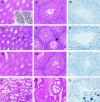Mice deficient for testis-brain RNA-binding protein exhibit a coordinate loss of TRAX, reduced fertility, altered gene expression in the brain, and behavioral changes
- PMID: 12944470
- PMCID: PMC193699
- DOI: 10.1128/MCB.23.18.6419-6434.2003
Mice deficient for testis-brain RNA-binding protein exhibit a coordinate loss of TRAX, reduced fertility, altered gene expression in the brain, and behavioral changes
Abstract
Testis-brain RNA-binding protein (TB-RBP), the mouse orthologue of the human protein Translin, is a widely expressed and highly conserved protein with proposed functions in chromosomal translocations, mitotic cell division, and mRNA transport and storage. To better define the biological roles of TB-RBP, we generated mice lacking TB-RBP. Matings between heterozygotes gave rise to viable, apparently normal homozygous mutant mice at a normal Mendelian ratio. The TB-RBP-related and -interacting protein Translin-associated factor X was reduced to 50% normal levels in heterozygotes and was absent in TB-RBP-null animals. The null mice were 10 to 30% smaller than their wild-type or heterozygote littermates at birth and remained so to about 6 to 9 months of age, showed normal B- and T-cell development, and accumulated visceral fat. TB-RBP-null male mice were fertile and sired offspring but had abnormal seminiferous tubules and reduced sperm counts. Null female mice were subfertile and had reduced litter sizes. Microarray analysis of total brain RNA from null and wild-type mice revealed an altered gene expression profile with the up-regulation of 14 genes and the down-regulation of 217 genes out of 12,473 probe sets. Numerous neurotransmitter receptors and ion channels, including gamma-aminobutyric acid A receptor alpha1 and glutamate receptor alpha3, were strongly down-regulated. Behavioral abnormalities were also seen. Compared to littermates, the TB-RBP-null mice appeared docile and exhibited reduced Rota-Rod performance.
Figures






References
-
- Allman, D., R. C. Lindsley, W. De Muth, K. Rudd, S. A. Shinton, and R. R. Hardy. 2001. Resolution of three nonproliferative immature splenic B cell subsets reveals multiple selection points during peripheral B cell maturation. J. Immunol. 167:6834-6840. - PubMed
-
- Alvarez, G. E., S. D. Beske, T. P. Ballard, and K. P. Davy. 2002. Sympathetic neural activation in visceral obesity. Circulation 106:2533-2536. - PubMed
-
- Aoki, K., J. Inazawa, T. Takahashi, K. Nakahara, and M. Kasai. 1997. Genomic structure and chromosomal localization of the gene encoding translin, a recombination hotspot binding protein. Genomics 43:237-241. - PubMed
-
- Aoki, K., R. Ishida, and M. Kasai. 1997. Isolation and characterization of a cDNA encoding a Translin-like protein TRAX. FEBS Lett. 401:109-112. - PubMed
-
- Aoki, K., K. Suzuki, R. Ishida, and M. Kasai. 1999. The DNA binding activity of Translin is mediated by a basic region in the ring-shaped structure conserved in evolution. FEBS Lett. 443:363-366. - PubMed
Publication types
MeSH terms
Substances
Grants and funding
LinkOut - more resources
Full Text Sources
Molecular Biology Databases
